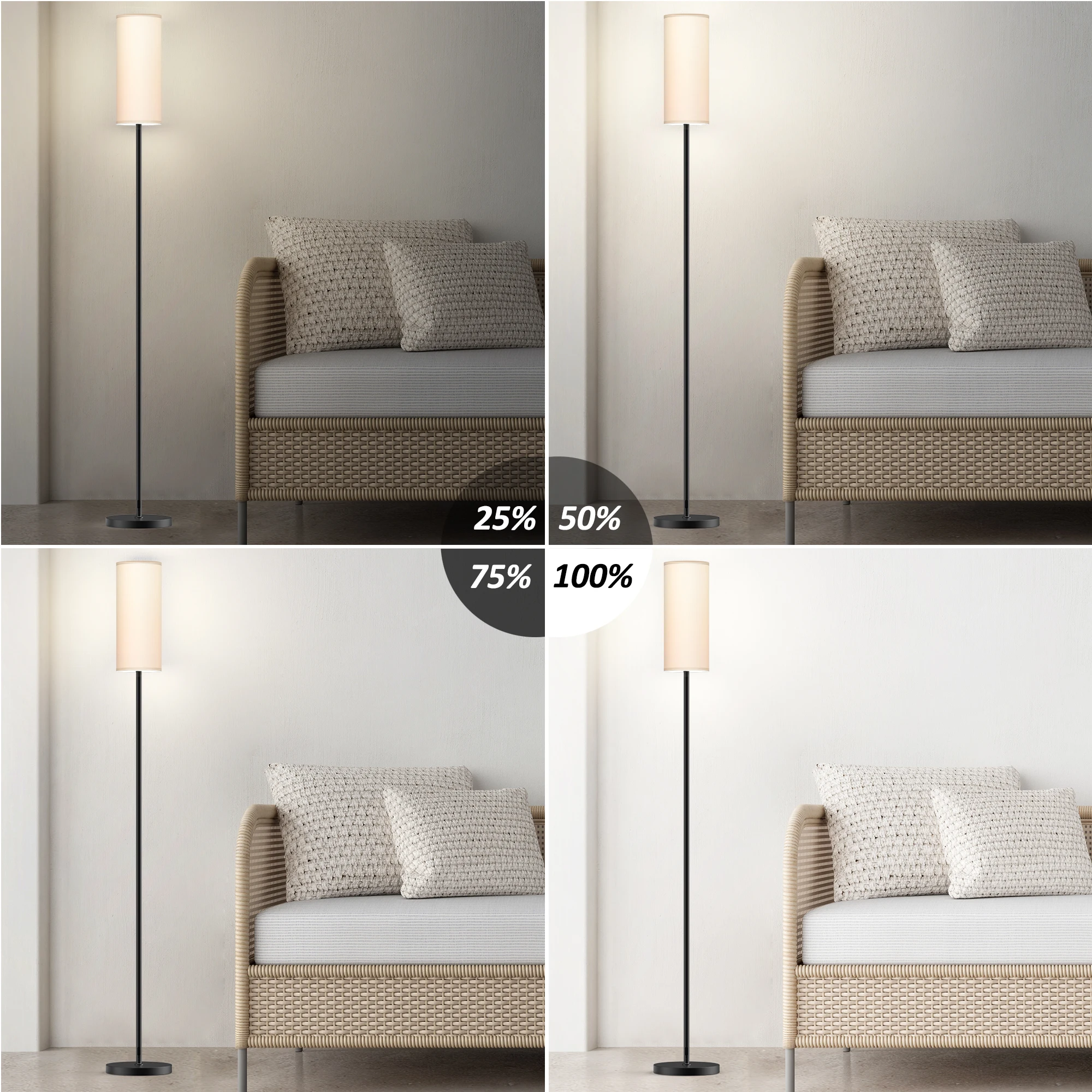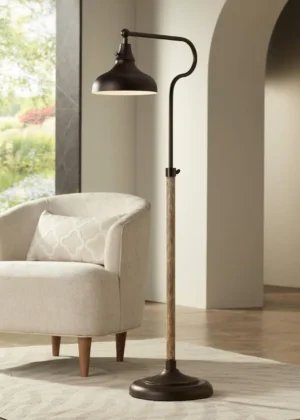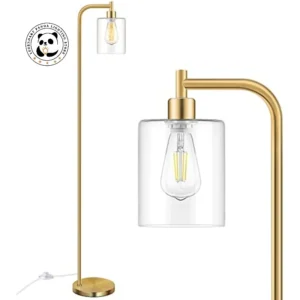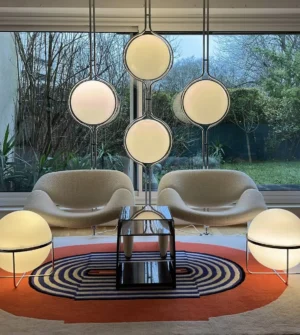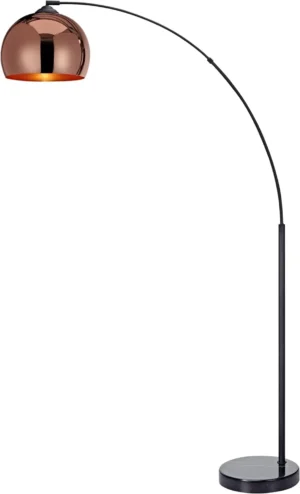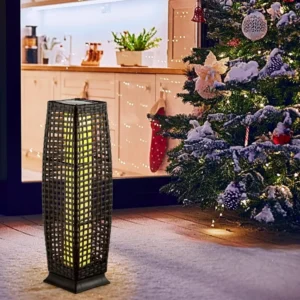Introduction: Creating Your Ideal Reading Sanctuary with Arc Lighting
Creating a perfect reading corner is about combining three essential elements: comfort, functionality, and aesthetic appeal. At the heart of this sanctuary lies one critical component that influences all three – proper lighting. Without adequate illumination, even the most comfortable chair and engaging book won’t create the reading experience you deserve.
Arc lamps offer an elegant and practical lighting solution that specifically benefits reading spaces in ways other lighting options simply cannot match:
- They provide targeted illumination precisely where you need it while maintaining an open, uncluttered feel
- Their space-efficient design keeps floor space free while directing light from overhead
- They serve as stunning design statements that enhance your décor while fulfilling a practical purpose
- Their flexibility allows for adjustments as your reading needs change throughout the day
Many readers struggle with inadequate lighting that causes eye strain, headaches, and diminished reading enjoyment. In fact, studies show that improper reading light can contribute to significant eye fatigue within just 30 minutes. Interior designers consistently emphasize that task lighting for reading requires specific positioning and quality to protect eye health and enhance the reading experience.
In this comprehensive guide, you’ll discover how to select the perfect arc lamp for your reading needs, position it optimally, choose the right light quality, integrate it beautifully into your space, and make the most of even small reading corners. The principles of arc lamps for reading corners combine both science and art to create the perfect illuminated sanctuary.
The Perfect Arc Lamp: Essential Features for Reader-Friendly Lighting
When selecting an arc lamp specifically for reading, certain functional features significantly impact your reading comfort and enjoyment. Not all arc lamps are created equal, and understanding these key elements will help you choose wisely.
Critical Features for Reading Comfort
Adjustability: The most valuable feature in a perfect arc lamp for reading nooks is its flexibility. Look for:
– Height adjustability (ideally 60-72 inches or 152-183 cm total height)
– Arm reach that extends 30-40 inches (76-102 cm) from the base
– Head rotation capability of at least 180 degrees to direct light precisely
– Easy adjustment mechanisms that don’t require tools
Light Output Controls: For comfortable reading sessions, your lamp should offer:
– Dimming capabilities (ideally continuous rather than stepped)
– Brightness range between 450-800 lumens
– Color temperature options if possible (more on this later)
Shade Design: The shade significantly affects light distribution and glare:
– Downward-facing shades direct light onto reading material rather than into eyes
– Semi-translucent materials provide diffused light that reduces harsh shadows
– Adjustable shade angles help customize light direction
Base Stability: A reading lamp should never wobble or tip:
– Heavy bases (15-20 pounds or 6.8-9 kg minimum) prevent tipping
– Counterbalance design allows for extended reach without instability
– Low center of gravity design enhances stability
Control Accessibility: Nothing disrupts reading flow like struggling to adjust your light:
– Foot pedal switches allow adjustment without standing
– In-line switches should be positioned within easy reach
– Touch or remote controls offer ultimate convenience
Size Considerations for Your Space
The perfect arc lamp should harmonize with your space’s dimensions. In general:
– For standard 8-foot (2.4 m) ceilings, look for lamps with maximum heights of 6-7 feet (1.8-2.1 m)
– Allow 16-24 inches (40-60 cm) of clearance around the lamp for easy adjustment
– Consider the arc’s reach in relation to your seating – it should extend comfortably over your reading position
Many adjustable arc floor lamps offer the versatility needed for reading corners, allowing you to customize both height and angle for optimal illumination regardless of your space constraints.
Materials Matter Beyond Aesthetics
While appearance is important, materials also affect durability and functionality:
– Metal arms provide better stability and less sway than plastic alternatives
– Weighted marble or stone bases offer superior stability
– Quality metal finishes resist fingerprints and cleaning damage
– Heat-resistant shade materials prevent warping from bulb heat
By prioritizing these essential features, you’ll select an arc lamp that not only beautifies your reading corner but also provides the practical illumination needed for hours of comfortable reading.
Strategic Placement: Positioning Your Arc Lamp for Optimal Reading Light
Proper positioning of your arc lamp is arguably the most crucial factor in creating ideal reading conditions. Understanding the fundamental principles of reading light will help you avoid eye strain and maximize comfort during extended reading sessions.
Fundamental Principles of Reading Light
The best reading light follows these established guidelines:
– Light should come from behind and slightly over your shoulder
– The light source should be higher than your head but not directly overhead
– Shadows should be minimized on your reading material
– Light should be concentrated on your book or device, not dispersed around the room
Precise Positioning Methods
Behind-the-Seating Approach
This classic positioning technique works well for most reading chairs and provides excellent illumination:
- Place the lamp base 24-30 inches (60-76 cm) behind your seating
- Position the base slightly offset from center (4-8 inches/10-20 cm to either side)
- Adjust the arc height so the bottom of the shade sits 18-24 inches (45-60 cm) above your shoulder
- Angle the shade to direct light onto your lap/reading material
- Ensure the lamp doesn’t cast shadows from your head onto the reading material
How to position arc lamps for reading involves finding the perfect balance between height and distance. If the lamp is too close, it may create glare; too far, and it won’t provide sufficient illumination.
Side Positioning Approach
When space behind the seating isn’t available, consider this alternative:
- Place the lamp base 18-24 inches (45-60 cm) to the side of your dominant reading arm
- Position it slightly forward of your seating (4-6 inches/10-15 cm)
- Extend the arc across your body at a 45° angle
- Adjust height so the shade sits approximately 20-26 inches (50-66 cm) above your reading material
- Angle the shade to minimize glare on glossy pages or screens
Corner Maximization Techniques
For tight spaces, this approach optimizes both illumination and space efficiency:
- Place the base in the corner behind your reading chair
- Position it at a 45° angle to both walls
- Extend the arc diagonally over your seating
- Adjust the height slightly higher than in other positions (24-30 inches/60-76 cm above reading material)
- Use wall proximity to your advantage by capturing reflected light
Avoiding Common Shadows and Glare
- Test your setup with different reading materials (glossy magazines, matte paper books, e-readers)
- Adjust your lamp while seated in your actual reading position
- Check for shadows created by your head, shoulders, or hands
- For right-handed readers, light generally works better coming from the left (and vice versa)
The most common positioning mistake is placing the lamp too far from the seating area. Remember that light intensity diminishes significantly with distance, following the inverse square law – when you double the distance, you get only one-fourth the illumination.
Light Quality for Eye Health: Selecting the Right Bulb and Settings
The quality of light your arc lamp produces has a profound impact on your reading comfort, eye health, and overall experience. Understanding the technical aspects of light quality will help you make informed choices about bulbs and settings.
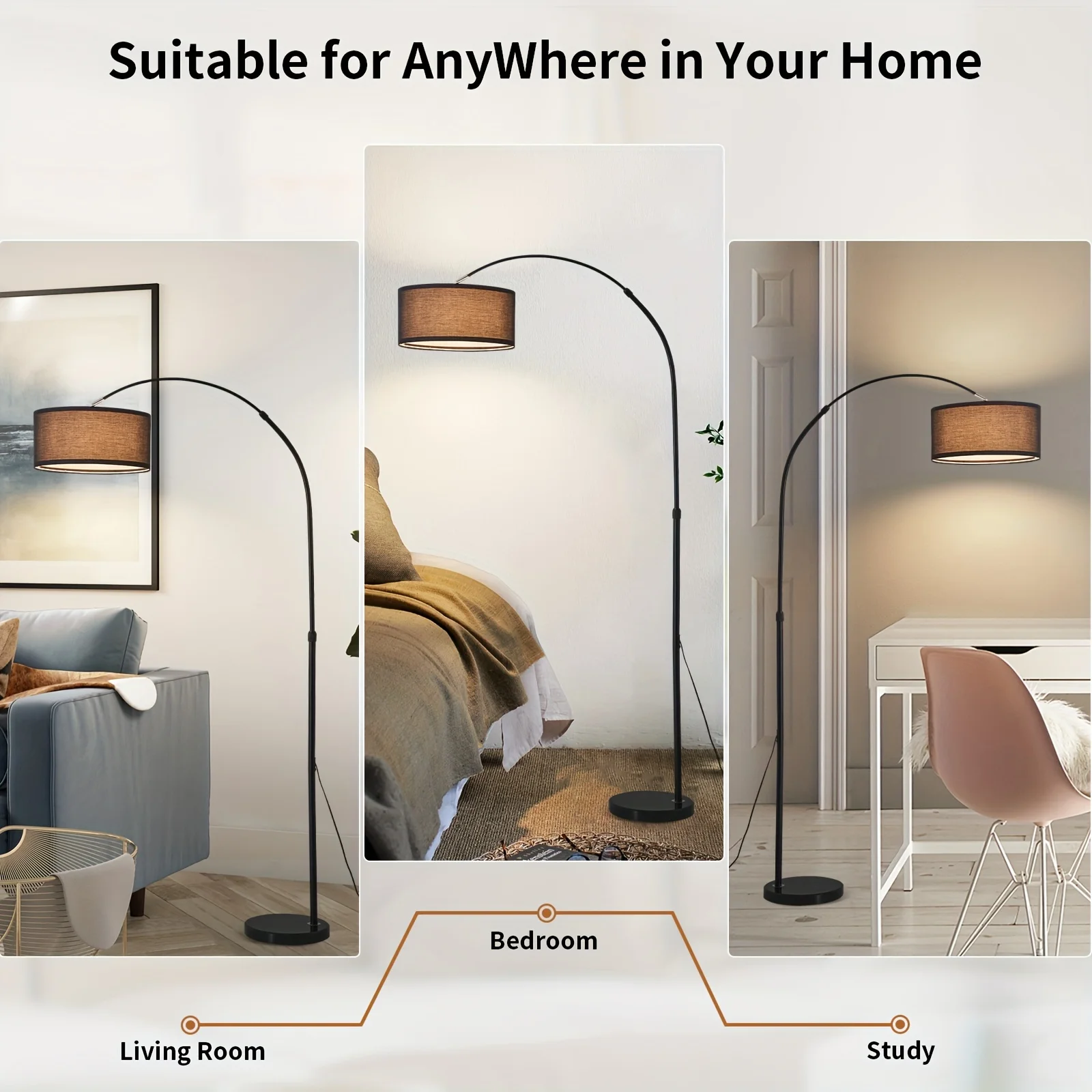
The Three Crucial Factors of Reading Light Quality
Color Temperature (Kelvin)
Color temperature dramatically affects both reading comfort and your body’s natural rhythms:
| Kelvin Range | Light Appearance | Best For | Reading Benefits |
|---|---|---|---|
| 2700K-3000K | Warm white/yellowish | Evening reading, fiction | Creates cozy atmosphere, doesn’t interfere with sleep hormones |
| 3000K-3500K | Neutral white | General reading, varied content | Balanced brightness without eye strain |
| 3500K-4000K | Cool white | Detailed tasks, textbooks, studying | Enhances contrast and alertness |
| 4000K+ | Daylight/bluish | Brief technical reading only | Not recommended for extended reading sessions |
For most readers, the sweet spot lies between 2700K-3500K, with the lower end better for evening reading and the higher end better for daytime or detailed work.
Brightness (Lumens)
The right brightness level prevents both eye strain from dim light and discomfort from excessive brightness:
– 450-550 lumens: Sufficient for casual reading in otherwise dim rooms
– 550-650 lumens: Ideal for most reading scenarios
– 650-800 lumens: Best for detailed reading or aging eyes
Soft lighting options for arc lamps can create the perfect balance between sufficient illumination and comfortable ambiance. Many dimmable arc floor lamps allow you to adjust brightness based on the time of day, reading material, and your personal comfort.
Color Rendering Index (CRI)
This less-known specification measures how accurately a light source reveals colors compared to natural daylight:
– Below 80 CRI: Poor color rendering, makes reading tiresome
– 80-90 CRI: Good color rendering, suitable for casual reading
– 90+ CRI: Excellent color rendering, reduces eye strain during extended reading
– 95+ CRI: Superior quality, best for color-critical reading (art books, design materials)
Research shows that higher CRI lighting (90+) can reduce eye strain by up to 30% during extended reading sessions compared to standard lighting.
LED vs. Traditional Bulbs for Reading
Modern LED options have largely surpassed traditional incandescent or halogen bulbs for reading purposes:
– LEDs produce less heat, making long reading sessions more comfortable
– They offer more precise control over color temperature
– Energy efficiency means brighter light with lower power consumption
– Longer lifespan reduces replacement frequency
– Many offer dimming capabilities without color shift
When selecting LED bulbs, look for those specifically designed for reading or task lighting, as they typically have higher CRI values and appropriate beam spread patterns.
Testing and Adjusting for Different Reading Materials
Different reading materials benefit from slightly different lighting approaches:
– Printed books with matte pages: Standard setting (550-650 lumens at 3000K)
– Glossy magazines: Slightly lower brightness to reduce glare (450-550 lumens)
– E-readers with e-ink: Similar to printed books
– Tablets/backlit devices: Lower brightness (400-500 lumens) and warmer temperature (2700K)
The Importance of Flicker-Free Lighting
Imperceptible light flicker causes significant eye strain during extended reading:
– Choose quality LED bulbs that advertise “flicker-free” operation
– Avoid using arc lamps on incompatible dimmer systems
– Be particularly cautious with budget bulbs, which often have higher flicker rates
By carefully selecting your bulb and adjusting settings appropriately, your arc lamp can create an eye-friendly environment that allows for hours of comfortable reading.
Aesthetic Integration: Making Your Arc Lamp a Design Statement
Beyond their functional role, arc lamps serve as sculptural elements that can dramatically enhance your reading corner’s visual appeal. Their distinctive curved silhouette creates a striking design statement while fulfilling the practical purpose of illuminating your reading material.
Arc Lamps as Functional Sculpture
Unlike standard floor lamps that stand vertically, arc lamps create visual interest through:
– Dynamic curved lines that draw the eye through the space
– Counterbalanced proportions that create a sense of tension and harmony
– The illusion of floating light that adds dimensional interest
– Strong architectural presence that anchors the reading area
Matching Materials and Finishes with Existing Decor
Coordinate your arc lamp with your existing elements by considering:
– Metal finishes that complement existing hardware (cabinet pulls, doorknobs)
– Base materials that echo other design elements in the room
– Shade materials and colors that harmonize with your textile palette
– Overall proportions that balance with surrounding furniture
Many black arc floor lamps offer excellent versatility across design styles, as their neutral finish complements almost any color scheme while providing contemporary sophistication.
Styling Approaches for Different Interior Design Themes
Modern Minimalist Integration
- Choose lamps with clean, simple lines and minimal ornamentation
- Opt for monochromatic color schemes (all black, all white, all metallic)
- Look for integrated LED designs rather than visible bulbs
- Emphasize geometric precision in positioning
Mid-Century Modern Pairings
- Select lamps with brass or gold-tone finishes
- Look for walnut wood elements or marble bases
- Choose textured or linen-inspired shades
- Position alongside low-profile furniture with tapered legs
Industrial Chic Coordination
- Focus on exposed elements and mechanical details
- Choose brushed metals, particularly steel and bronze
- Look for adjustable mechanisms that showcase engineering
- Pair with raw materials like reclaimed wood, concrete, or leather
Transitional Space Harmony
- Select designs with subtle curves rather than stark lines
- Blend metallic finishes with warm elements
- Choose neutral-colored shades in classic shapes
- Position to balance traditional and contemporary elements in the space
Scale and Visual Weight Considerations
The proportions of your arc lamp relative to your reading area significantly impact the visual harmony:
– The lamp’s height should generally be in proportion to ceiling height (approximately 75-85% of ceiling height)
– The arc’s reach should relate to the width of your seating (extending about 2/3 across a standard chair)
– The base size should be proportional to available floor space (larger bases for more spacious areas)
– The shade size should be scaled to the reading area (10-16 inches/25-40 cm diameter works for most settings)
By thoughtfully selecting and positioning your arc lamp, you create not just functional lighting but a cohesive design statement that elevates your entire reading corner.
Space-Saving Solutions: Maximizing Small Reading Corners with Arc Lamps
Limited space doesn’t mean compromising on proper reading light. In fact, arc lamps offer unique advantages for small reading corners that other lighting solutions cannot match.
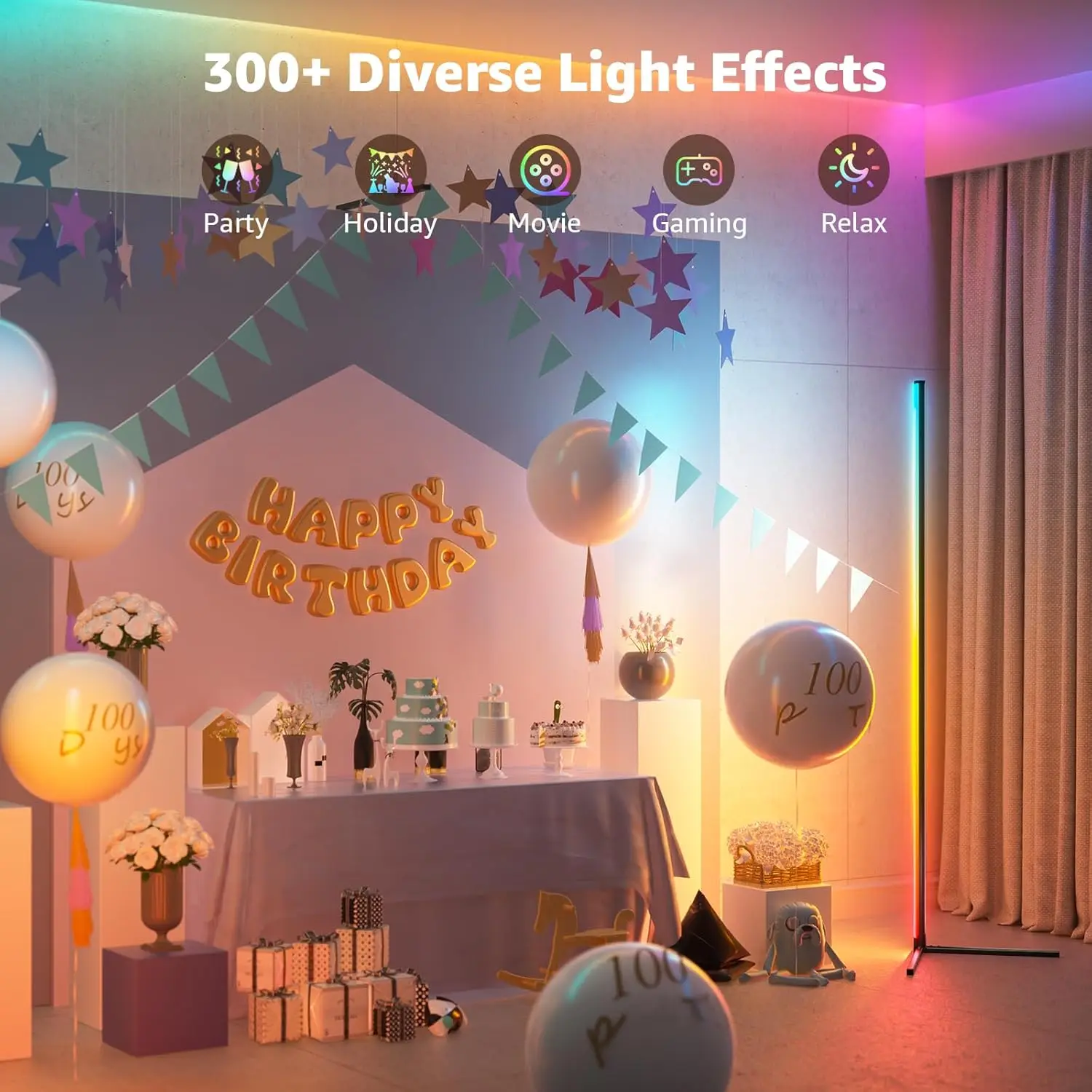
Why Arc Lamps Excel in Limited Spaces
Arc lamps provide distinct advantages in compact areas:
– They eliminate the need for side tables that would otherwise hold table lamps
– Their vertical height utilizes unused vertical space rather than precious floor area
– Their overhead light eliminates the need for wall-mounted fixtures that require installation
– Their all-in-one design reduces the number of lighting elements needed
Space-Saving Placement Strategies
Wall-Adjacent Placement
Positioning your arc lamp strategically against walls maximizes usable floor space:
– Place the lamp base flush against the wall behind your reading chair
– Position it where walls meet (corners) to utilize otherwise dead space
– Should lamps be in corner locations? For arc lamps, corner placement can be ideal, creating a natural frame for your reading area while minimizing the lamp’s footprint
Multi-Purpose Furniture Pairings
Clever furniture combinations can further optimize space:
– Position the arc lamp base partially under sofa or chair legs to reduce its footprint
– Use slender arc lamps with small bases (under 10 inches/25 cm diameter)
– Choose floor lamps with integrated shelving or tables
– Select LED arc floor lamps with slim profiles that require minimal space
Visual Space-Saving Through Design
Even when physical space is limited, certain design choices can create the illusion of more room:
– Choose arc lamps with transparent or translucent elements that don’t visually block space
– Select finishes that match your wall color to help the lamp visually recede
– Opt for designs with thin profiles rather than chunky elements
– Consider adjustable arcs that can be positioned differently as needed
Navigating Common Small-Space Challenges
Low Ceilings
When ceiling height is limited:
– Look for arc lamps with adjustable height mechanisms
– Choose models with shallower arcs (extending 24-30 inches/60-76 cm rather than 36+ inches/91+ cm)
– Position the base farther from your seating to create a less steep arc
– Select lamps with adjustable heads that can be angled appropriately despite height limitations
Awkward Corners
For challenging architectural spaces:
– Use the arc lamp to highlight rather than hide unusual angles
– Position the base in tight corners while extending the arc into usable space
– Choose highly adjustable models that can be configured around obstacles
– Consider counterbalanced designs that can extend over architectural features
Traffic Flow Considerations
In tight spaces where movement paths are critical:
– Position the base away from walkways, with the arc extending over seating
– Ensure the arc height allows for comfortable movement underneath (at least 6.5 feet/2 m clearance)
– Choose models with secure bases that won’t shift if accidentally bumped
– Consider the full swing radius when adjusting the lamp to avoid obstacles
With thoughtful selection and positioning, an arc lamp can transform even the smallest reading corner into a well-lit, comfortable retreat that feels spacious and intentionally designed.
Installation and Setup: Ensuring Safety and Optimal Performance
Proper installation and setup of your arc lamp ensures both safety and optimal lighting performance for your reading corner. Follow these steps to achieve the best results.
Assembly and Installation Steps
- Clear the area – Create ample space for assembly, removing any obstacles
- Unpack carefully – Inspect all components for damage before assembly
- Follow manufacturer instructions – Pay special attention to weight-bearing connections
- Assemble the base first – Ensure it’s completely stable before attaching the arm
- Secure all connections – Tighten all screws, bolts, and fasteners completely
- Install appropriate bulb – Match the bulb type and wattage to manufacturer specifications
- Position the lamp – Place it in your pre-determined location
- Fine-tune adjustments – Set the perfect height and angle for your reading position
Elegant Cable Management
Exposed cords can diminish the visual appeal of even the most beautiful arc lamp:
– Route the cord along the inside of the arc when possible
– Use clear cord clips to secure excess cord along the arc
– Consider cord covers that match your floor or wall color
– For hardwood floors, route cords under area rugs when possible
– Keep cord paths away from high-traffic areas
Testing and Fine-Tuning
After initial setup, take time to optimize your lamp’s performance:
1. Test the lighting at different times of day
2. Sit in your reading position and adjust the lamp while seated
3. Check for shadows or glare on different reading materials
4. Verify that controls are easily accessible from your seated position
5. Make small adjustments (1-2 inches/2.5-5 cm) to fine-tune light distribution
Safety Considerations
Stability Checks
- Ensure the base sits completely flat on the floor without wobbling
- Test stability by gently pushing the arc from various angles
- For homes with children or pets, consider additional stability measures like adhesive base pads
- Marble base arc floor lamps offer excellent stability due to their substantial weight and low center of gravity
Electrical Safety
- Keep connections away from water sources
- Never exceed the maximum recommended bulb wattage
- Inspect cords periodically for damage or wear
- Use surge protectors for lamps with electronic components
- Consider professional installation for lamps that require electrical hardwiring
Child and Pet Safety
- Select lamps with weighted bases that resist tipping
- Keep cords secured and out of reach
- Choose models with cool-running LED bulbs to prevent burns
- Consider lamp height relative to curious children or jumping pets
Troubleshooting Common Issues
- If the lamp wobbles: Check that all parts are fully tightened and the floor is level
- If dimmer functions aren’t working properly: Verify bulb compatibility with dimming
- If the arm doesn’t hold position: Check tension adjustments or contact the manufacturer
- If light seems insufficient: Verify you’re using the correct bulb type and wattage
Taking time to properly install and fine-tune your arc lamp ensures years of safe, effective, and enjoyable lighting for your reading sanctuary.
Creating a Layered Lighting Scheme: Complementary Lighting for Your Reading Corner
While an arc lamp provides excellent task lighting for reading, integrating it into a thoughtfully layered lighting scheme creates a more versatile and comfortable environment for your reading corner.
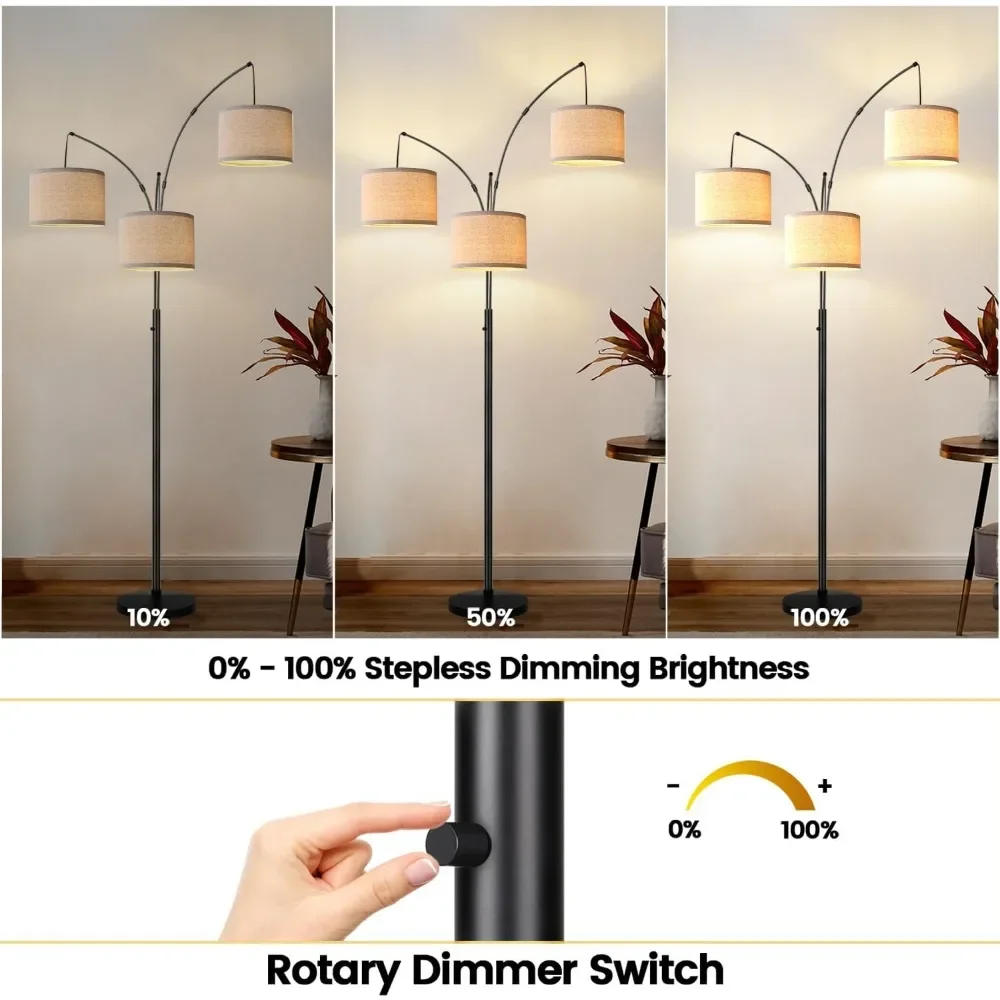
Understanding Layered Lighting Principles
A well-designed lighting plan incorporates three distinct layers:
– Ambient lighting provides overall illumination for the entire space
– Task lighting (your arc lamp) focuses bright light on specific activities
– Accent lighting adds visual interest and highlights decorative elements
Your arc lamp serves primarily as task lighting, but mastering ambient lighting with arc lamps can help them contribute to other lighting layers as well, especially when using adjustable models.
Combining Arc Lamp Lighting with Natural Daylight
Natural light creates the ideal reading environment, but needs management:
– Position your reading corner near a window when possible, with the arc lamp supplementing as needed
– Arrange seating so natural light comes from behind or beside you, never directly in front
– Use window treatments to control glare and light intensity throughout the day
– As natural light diminishes, gradually increase your arc lamp’s brightness
Adjustable Arc Floor Lamp, Bronze Arc Floor Lamp
Price range: $440.95 through $558.52 Select options This product has multiple variants. The options may be chosen on the product pageBrass Arc Floor Lamp, Contemporary Arc Floor Lamp, LED Arc Floor Lamp
Price range: $490.72 through $522.04 Select options This product has multiple variants. The options may be chosen on the product pageChrome Arc Floor Lamp, LED Arc Floor Lamp
Price range: $304.95 through $1,210.40 Select options This product has multiple variants. The options may be chosen on the product pageContemporary Arc Floor Lamp, Large Arc Floor Lamp, Marble Base Arc Floor Lamp
$224.94 Select options This product has multiple variants. The options may be chosen on the product pageLED Arc Floor Lamp, Rattan Arc Floor Lamp
$313.58 Select options This product has multiple variants. The options may be chosen on the product page- $1,003.85 Select options This product has multiple variants. The options may be chosen on the product page
Ambient Room Lighting Integration
Your arc lamp works best when complemented by appropriate ambient lighting:
– Keep ambient ceiling lights at lower intensity than your task lighting
– Create at least a 3:1 ratio between your reading light and the surrounding room
– Use warm ambient lighting (2700K-3000K) to create a cozy atmosphere
– Consider dimmable ambient options to adjust throughout the day
3-light arc floor lamps can serve double duty, with one light directed specifically for reading and others providing ambient illumination for the broader space.
Additional Task Lighting Considerations
Sometimes a single arc lamp may need supplementation:
– For very detailed work or aging eyes, add a secondary small task light
– For reading areas used by two people simultaneously, consider dual-headed arc lamps
– For spaces that serve multiple purposes, incorporate adjustable task lighting that can be repositioned
Lighting Transitions Throughout the Day
Your reading corner’s lighting needs change from morning to night:
– Morning: Complement bright natural light with minimal artificial lighting
– Afternoon: Gradually increase lamp brightness as daylight becomes more angular
– Evening: Switch to warmer light temperatures (2700K) at medium-high brightness
– Late night: Maintain warm light but reduce brightness to prevent disrupting sleep cycles
Smart Lighting Integration for Ultimate Control
Modern technology allows unprecedented control over your reading environment:
– Smart bulbs with adjustable color temperature let you transition throughout the day
– Voice-controlled systems allow adjustments without interrupting your reading
– Programmable scenes can create one-touch perfect lighting for different activities
– Light sensors can automatically balance artificial light with available natural light
By thoughtfully combining your arc lamp with complementary lighting sources, you create a reading corner that adapts to your needs throughout the day and supports both the functional and atmospheric aspects of your reading experience.
Maintenance and Care: Preserving Your Arc Lamp’s Performance
Proper maintenance ensures your arc lamp continues providing optimal reading light for years to come. These simple care routines will preserve both functionality and appearance.
Cleaning Techniques for Different Materials
Metal Finishes:
– Dust regularly with a soft, dry microfiber cloth
– For fingerprints on chrome or stainless steel, use a small amount of glass cleaner on a cloth
– Clean brass or copper finishes with specific metal cleaners or a solution of equal parts white vinegar, salt, and flour
– Never use abrasive cleaners or scrubbers on any metal finish
Fabric Shades:
– Dust weekly with a lint roller or vacuum using a brush attachment
– Spot clean with mild soap and water, blotting rather than rubbing
– Allow to air dry completely before using the lamp again
– For stubborn stains, consult manufacturer guidelines
Glass or Acrylic Components:
– Clean with a soft cloth dampened with water or glass cleaner
– Spray cleaning solution on the cloth, never directly on the lamp
– Dry immediately with a lint-free cloth to prevent water spots
Marble or Stone Bases:
– Dust with a soft, dry cloth regularly
– Clean with stone-specific cleaners only
– Avoid acidic cleaners that can etch the surface
– Consider sealing marble bases annually to prevent staining
Bulb Replacement Procedures
- Turn off and unplug the lamp, allowing it to cool completely
- Check manufacturer specifications for compatible bulb types
- Handle new bulbs with clean hands or gloves (oils from skin can reduce bulb lifespan)
- Install the new bulb carefully, avoiding over-tightening
- Dispose of old bulbs properly according to local regulations (especially important for CFLs containing mercury)
Routine Maintenance Checks
Monthly:
– Check all connections and tighten any loose parts
– Inspect the electrical cord for wear or damage
– Test stability by gently pushing the arc in different directions
– Verify dimmer function works smoothly across its full range
Quarterly:
– Clean all surfaces thoroughly
– Check balance and readjust if necessary
– Inspect socket for signs of heat damage or wear
– Verify all adjustment mechanisms operate smoothly
Annually:
– Check all electrical connections
– Consider replacing bulbs proactively if used daily
– Lubricate any moving parts if recommended by manufacturer
– Re-level the base if the floor has settled or changed
Troubleshooting Common Issues
Dimmer Function Problems:
– Verify bulb compatibility with dimming
– Check for loose connections at the dimmer switch
– Replace the dimmer if it operates inconsistently
Balance and Stability Concerns:
– Tighten all connections where components meet
– Verify the base sits evenly on the floor
– Check that weight is properly distributed
– Ensure adjustable components are secured in their settings
Light Quality Degradation:
– Replace bulbs that have passed 70% of their rated lifespan
– Clean dust from shades and bulbs, which can reduce light output
– Check for shade discoloration from heat exposure
– Ensure the lamp hasn’t shifted from its optimal position
With regular maintenance and prompt attention to any developing issues, your arc lamp will continue providing the perfect reading light while maintaining its visual appeal for many years.
Frequently Asked Questions About Arc Lamps for Reading
Can an arc lamp provide enough light for detailed reading tasks?
Yes, arc lamps can absolutely provide sufficient light for detailed reading, including fine print and intricate diagrams. The key is selecting a lamp that delivers 550-800 lumens with proper positioning. For optimal results, choose models with adjustable brightness and position the light source 18-24 inches (45-60 cm) above your reading material. Choosing the perfect reading lamp involves balancing brightness, positioning, and color temperature appropriate for your specific reading needs.
How do I eliminate glare when using an arc lamp for reading?
To eliminate glare, first ensure your lamp shade directs light downward onto your reading material rather than outward toward your eyes. Position the lamp so light comes from behind your shoulder, not from in front or directly overhead. For glossy magazines or screens, reduce brightness slightly and increase the lamp’s height by 2-3 inches (5-8 cm). Adjustable arc lamps designed for reading offer the flexibility to fine-tune positioning until you achieve glare-free illumination.
Will an arc lamp work with an e-reader or tablet?
Arc lamps work excellently with e-readers and tablets when properly adjusted. For e-ink readers like Kindle Paperwhite, use similar settings as for printed books. For backlit tablets or iPads, reduce your arc lamp’s brightness to about 400-500 lumens and use a warmer color temperature (2700K-3000K) to reduce eye strain. Position the lamp to minimize screen reflections by testing different angles while seated in your reading position.
What’s the best color temperature for evening reading?
For evening reading, the ideal color temperature ranges from 2700K to 3000K, creating a warm, slightly yellowish light similar to traditional incandescent bulbs. This warmer light minimizes blue light exposure that can interfere with melatonin production and sleep patterns. If you read for extended periods before sleeping, gradually decrease both brightness and color temperature as bedtime approaches. Many readers find that 2700K light about 60-90 minutes before sleep provides comfortable illumination without disrupting sleep quality.
Are arc lamps suitable for readers with specific visual needs?
Arc lamps can be excellent for readers with visual impairments or specific visual needs when properly selected. For aging eyes or those with vision challenges, look for models offering higher brightness (700-900 lumens), excellent color rendering (90+ CRI), and highly adjustable positioning. Some readers with macular degeneration benefit from cooler color temperatures (3500K-4000K) that enhance contrast. Lamps with multiple brightness settings allow customization as vision needs change or fatigue sets in during extended reading sessions.

